全文HTML
--> --> -->试验优化设计是一种可以通过少量试验来获取全面试验信息的科学试验方法. 试验优化设计有很多设计方法, 其中均匀试验设计和二次通用旋转组合设计是常用的优化设计方法. 均匀试验设计可以通过少量试验确定合理的试验范围, 二次通用旋转组合设计可建立研究对象的回归模型, 该回归模型不仅具有通用性、旋转性, 还能大量减少试验次数, 并可对所得的回归模型进行准确寻优. 尽管试验优化设计理论在很多研究领域得到了应用, 但将其应用于发光材料的合成研究还是一种科学新颖的方法[14,15].
本文运用均匀试验设计和二次通用旋转组合设计相结合的试验方法, 对Er3+/Yb3+共掺Ba5Gd8Zn4O21上转换荧光粉的掺杂浓度进行寻优[16]. 首先使用均匀试验设计的方法确定稀土离子的合理掺杂浓度范围, 再应用二次通用旋转组合设计的方法, 根据试验结果建立Ba5Gd8Zn4O21掺杂Er3+/Yb3+的二次回归方程, 对回归方程及各项系数进行显著性检验后, 通过遗传算法求得方程最优解, 即荧光粉红光最大发光强度对应的Er3+/Yb3+的最佳离子掺杂浓度[17—19]. 试验采用高温固相法, 按Er3+/Yb3+最佳离子浓度制备出最优样品, 将最优样品与NaYF4红光商品粉的发光强度进行比较, 并对其发光性质进行了研究[20].
2.1.实验方法
将实验用分析纯ZnO, BaCO3, Gd2O3, Yb2O3, Er2O3作为原料, 将原料按一定摩尔系数比进行称量, 并将称量好的原料置于洗净的玛瑙研钵内, 充分研磨至原料混合均匀, 将得到的混合物装入刚玉坩埚内, 然后放入马弗炉中, 在1300 ℃下保温4 h, 自然降温冷却后得到块状样品, 将其研磨成粉末状, 即为所需的样品[8].使用日本岛津Shimadzu-6000型X射线衍射仪(XRD)对样品的晶体结构进行表征, 采用Cu靶


2
2.2.试验优化设计
32.2.1.均匀试验设计
为寻找Ba5Gd8Zn4O21荧光粉在1550 nm和980 nm激光激发下的最大红色发光强度所对应的Er3+/Yb3+掺杂浓度, 选用U9(96)进行均匀设计. 使样品在1550 nm和980 nm激光激发下得到上转换发射光谱, 并分别对发射光谱中的红色发光部分积分, 得到的积分强度见表1. 通过比较, 在1550 nm和980 nm激光激发下得到最强红光对应的Er3+/Yb3+浓度分别是Er3+为6%, Yb3+为7.875%和Er3+为8%, Yb3+为6.5%. 以这组Er3+/ Yb3+离子浓度为参考, 确定Er3+/Yb3+的掺杂浓度范围分别为Er3+ 4%—9%, Yb3+ 4%—9%, 将此浓度范围用于二次通用旋转组合设计中.| 因素试验 序号 | x1 (Er3+)/ mol% | x2 (Yb3+)/ mol% | y1550 nm | y980 nm |
| 1 | 1(1) | 4(5.125) | 3328.2 | 62033.4 |
| 2 | 2(2) | 8(10.625) | 11605.2 | 101937.9 |
| 3 | 3(3) | 3(3.75) | 32949.3 | 90471.5 |
| 4 | 4(4) | 7(9.25) | 38447.2 | 99822.8 |
| 5 | 5(5) | 2(2.375) | 79416.9 | 69237.5 |
| 6 | 6(6) | 6(7.875) | 145038.5 | 123959.0 |
| 7 | 7(7) | 1(1) | 132225.6 | 38588.2 |
| 8 | 8(8) | 5(6.5) | 155258.0 | 112564.1 |
| 9 | 9(9) | 9(12) | 105986.7 | 75933.5 |
表1均匀试验设计
Table1.Uniform experimental design.
3
2.2.2.二次通用旋转组合设计
为了使二次通用旋转组合设计具有通用性、旋转性等优异性质, 并符合建模和检验的要求, 因此需要进行因素编码, 表2是此次二次通用旋转组合设计的因素编码表. 二次通用旋转组合设计试验的方案与结果如列于表3. 共进行13组样品试验, 并分别对样品的红光部分进行积分, 积分面积分别用
| zj(xj) | z1(Er3+)/mol% | z2(Yb3+)/mol% |
| z2j(2) | 9 | 9 |
| z0j + ${\varDelta _j} $(1) | 8.2680 | 8.2680 |
| z0j(0) | 6.5 | 6.5 |
| z0j – $ {\varDelta _j}$(–1) | 4.7320 | 4.7320 |
| z1j(–2) | 4 | 4 |
| ${\varDelta _j} = \dfrac{{{z_{2j}} - {z_{1j}}}}{{2r}}$ | 1.7680 | 1.7680 |
| ${x_j} = \dfrac{{{z_j} - {z_{0j}}}}{{{\varDelta _j}}}$ | ${x_1} = \dfrac{{{z_1} - {\rm{6}}.{\rm{5}}}}{{{\rm{1}}.{\rm{7680}}}}$ | ${x_2} = \dfrac{{{z_2} - {\rm{6}}.{\rm{5}}}}{{{\rm{1}}.{\rm{7680}}}}$ |
表2自然因素水平编码表
Table2.Natural factors level codes.
| 序号 | x0 | x1 | x2 | x1x2 | x12 | x22 | y1550 nm | y980 nm |
| 1 | 1 | 1 | 1 | 1 | 1 | 1 | 129443 | 76365 |
| 2 | 1 | 1 | –1 | –1 | 1 | 1 | 124201 | 54268 |
| 3 | 1 | –1 | 1 | –1 | 1 | 1 | 120440 | 89291 |
| 4 | 1 | –1 | –1 | 1 | 1 | 1 | 100410 | 65430 |
| 5 | 1 | 1.414 | 0 | 0 | 2 | 0 | 127744 | 67758 |
| 6 | 1 | –1.414 | 0 | 0 | 2 | 0 | 101623 | 73300 |
| 7 | 1 | 0 | 1.414 | 0 | 0 | 2 | 112067 | 82410 |
| 8 | 1 | 0 | –1.414 | 0 | 0 | 2 | 109503 | 53292 |
| 9 | 1 | 0 | 0 | 0 | 0 | 0 | 120229 | 86752 |
| 10 | 1 | 0 | 0 | 0 | 0 | 0 | 123993 | 80120 |
| 11 | 1 | 0 | 0 | 0 | 0 | 0 | 124176 | 82245 |
| 12 | 1 | 0 | 0 | 0 | 0 | 0 | 118780 | 96762 |
| 13 | 1 | 0 | 0 | 0 | 0 | 0 | 108829 | 86738 |
表3二次通用旋转组合设计的试验方案及红光发光强度
Table3.Red luminescence intensity and experiment scheme of quadratic general rotary unitized design.
3.1.数据分析与结果讨论
根据试验结果中的红光部分可初步建立在编码空间中的回归方程:| 方差来源 | 偏差平方和1 | 偏差平方和2 | 自由度 | t1统计量及F1比 | t2 | 显著性水平α1 | 显著性水平α2 | 显著性1 | 显著性2 |
| x0 | — | — | 1 | 42.61 | 30.19 | 0.001 | 0.001 | **** | **** |
| x1 | — | — | 1 | 2.30 | 1.03 | 0.1 | 0.4 | *** | * |
| x2 | — | — | 1 | 0.95 | 2.80 | 0.4 | 0.02 | * | *** |
| x1x2 | — | — | 1 | 1.18 | 0.14 | 0.4 | 0.9 | * | 不显著 |
| x12 | — | — | 1 | 0.29 | 3.05 | 0.8 | 0.02 | 不显著 | *** |
| x22 | — | — | 1 | 1.11 | 3.60 | 0.4 | 0.02 | * | *** |
| 回归 | 991488682.6 | 1960893448 | 5 | 12.03 | 18.77 | 0.01 | 0.01 | **** | **** |
| 剩余 | 115427203 | 146280989.8 | 7 | — | — | — | — | — | — |
| 失拟 | 43457130.87 | 15074730.26 | 3 | 1.11 | 0.37 | 0.01 | 0.01 | **** | **** |
| 误差 | 156531329.6 | 164236197.2 | 4 | — | — | — | — | — | — |
| 总和 | 1106915886 | 2107174438 | 12 | — | — | — | — | — | — |
| 注: ****极高显著水平(α ≤ 0.01); ***高显著性水平(α ≤ 0.1); **显著水平(α ≤ 0.25); *较显著水平(α ≤ 0.4). | |||||||||
表4红光的T-检验及F-检验方差分析
Table4.T-test and F-test with analysis of variance of red light
对回归方程系数进行T-检验, 将回归方程(1)中不显著项


图1为1550 nm激光激发下Ba5Gd8Zn4O21∶Er3+/Yb3+样品的上转换发射光谱, 可以明显看到红光的发光强度很强, 相比之下绿光的发光强度较弱, 蓝光的发光强度非常弱, 插图是1550 nm激光激发下1号样品与最优样品发光强度对比图, 可以看到最优样品在1550 nm激光激发下比1号样品的发光更强. 图2给出了980 nm激光激发下Ba5Gd8Zn4O21∶Er3+/Yb3+样品的上转换发射光谱, 红光发光较强, 绿光发光较弱, 蓝光的发光强度非常弱, 插图是980 nm激光激发下3号样品与最优样品的发光强度对比图, 可知最优样品在980 nm激光激发下比3号样品的发光更强. 其中红光的发光中心位于662 nm, 对应于4F9/2 → 4I15/2能级跃迁[21,22].
 图 1 Er3+/Yb3+共掺Ba5Gd8Zn4O21在1550 nm激光激发下的上转换发射光谱(插图为1号样品与最优样品的发光强度对比)
图 1 Er3+/Yb3+共掺Ba5Gd8Zn4O21在1550 nm激光激发下的上转换发射光谱(插图为1号样品与最优样品的发光强度对比)Figure1. Up-conversion emission spectra of Er3+/Yb3+ co-doped Ba5Gd8Zn4O21 phosphor under 1550 nm laser excitation. Inset picture shows the luminescence intensity of No. 1 sample and the optimal sample for comparison.
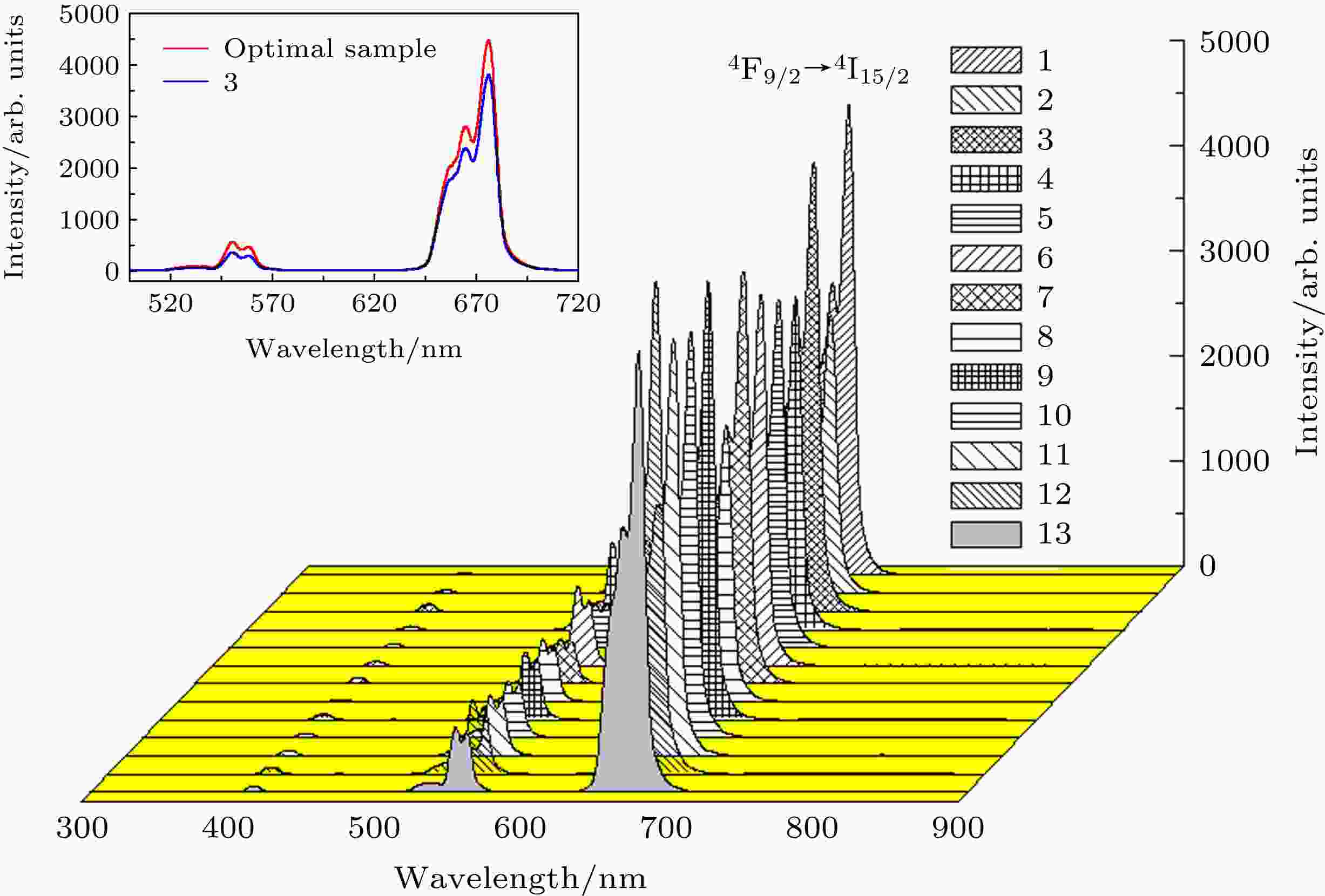 图 2 Er3+/Yb3+共掺Ba5Gd8Zn4O21在980 nm激光激发下的上转换发射光谱(插图为3号样品与最优样品的发光强度对比)
图 2 Er3+/Yb3+共掺Ba5Gd8Zn4O21在980 nm激光激发下的上转换发射光谱(插图为3号样品与最优样品的发光强度对比)Figure2. Up-conversion emission spectra of Er3+/Yb3+ co-doped Ba5Gd8Zn4O21 phosphor under 980 nm laser excitation. Inset picture shows the luminescence intensity of No. 3 sample and the optimal sample for comparison.
2
3.2.最优样品的晶体结构表征
图3(a)对应着Er3+/Yb3+共掺中Yb3+最大浓度样品的XRD图样, 图3(b)对应着Er3+/Yb3+共掺中Er3+最大浓度样品的XRD图样, 图3(c)对应着1550 nm激光激发下红光最优样品的XRD图样, 图3(d)对应着980 nm激光激发下红光最优样品的XRD图样; 图3(e)给出了Ba8Gd5Zn4O21粉末衍射的标准卡片JCPDS card No. 51-1686. 经过对比可以看出, 图3(a)—(d)的XRD图样与标准卡片的衍射峰位置一致, 于是可以确认合成的Ba8Gd5Zn4O21∶Er3+/Yb3+粉末样品为纯相. 由于Gd3+与Er3+/Yb3+的离子半径接近, 所以并没有使共掺的Ba8Gd5Zn4O21的晶体结构发生改变而产生衍射峰的偏移[23].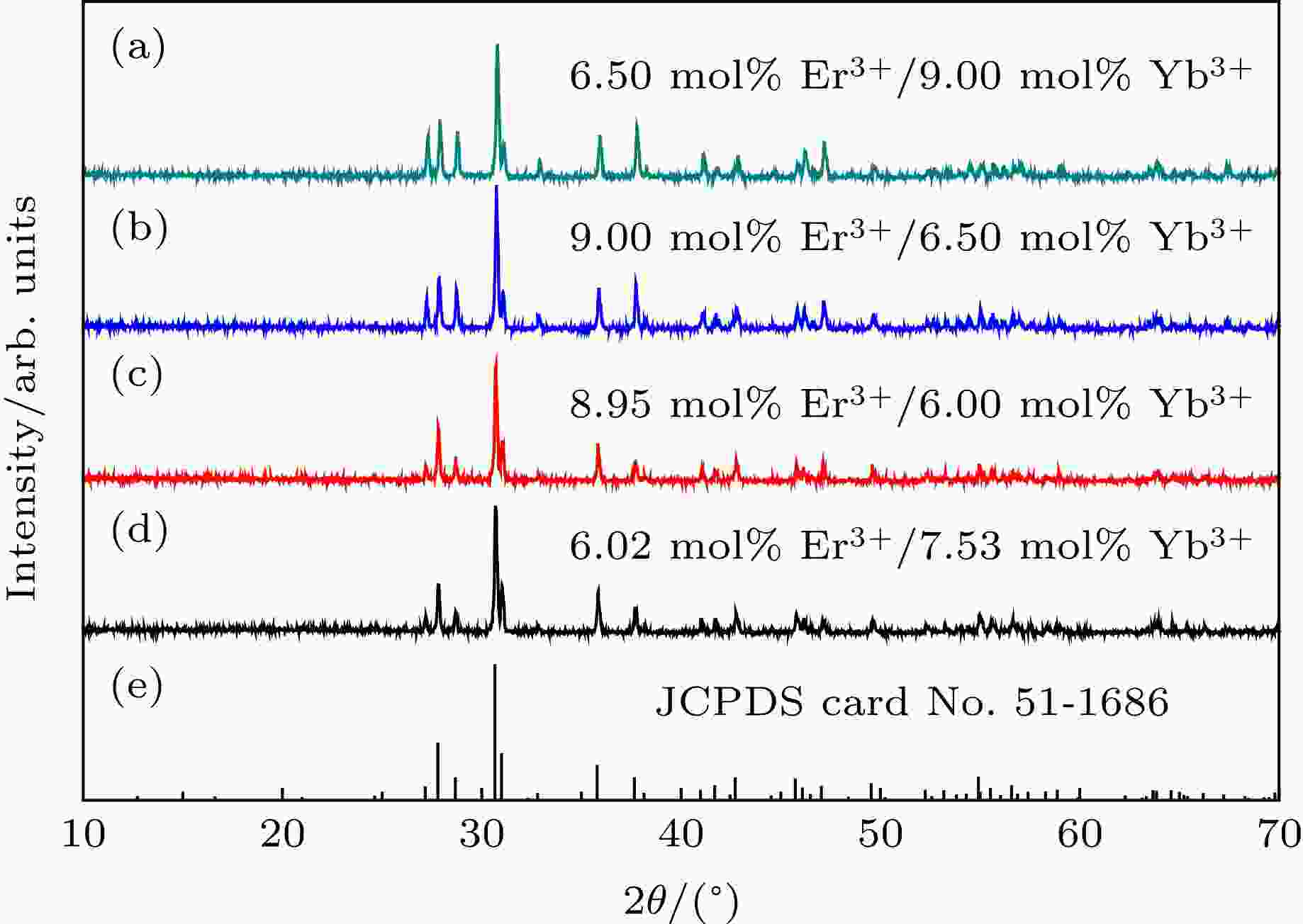 图 3 样品的XRD与标准卡片JCPDS No.51-1686图样
图 3 样品的XRD与标准卡片JCPDS No.51-1686图样Figure3. XRD patterns of samples, and standard peaks of Ba8Gd5Zn4O21 (JCPDS No.51-1686) are included for comparison.
2
3.3.最优样品的上转换发光机制
为了进一步探索研究最优样品的上转换发光机制, 将最优样品分别在不同工作电流的1550 nm和980 nm激光下激发并对红色发光部分积分. 另外, 为了避免由于激发功率密度过高而对样品产生激光致热效应, 把激光器工作电流控制在相对较低的范围内, 使得对发光机制的分析误差更小. 已知稀土离子的上转换发光过程是由稀土离子吸收两个或两个以上的长波长光子而产生一个短波长光子的过程, 由于在上转换发光过程发光强度

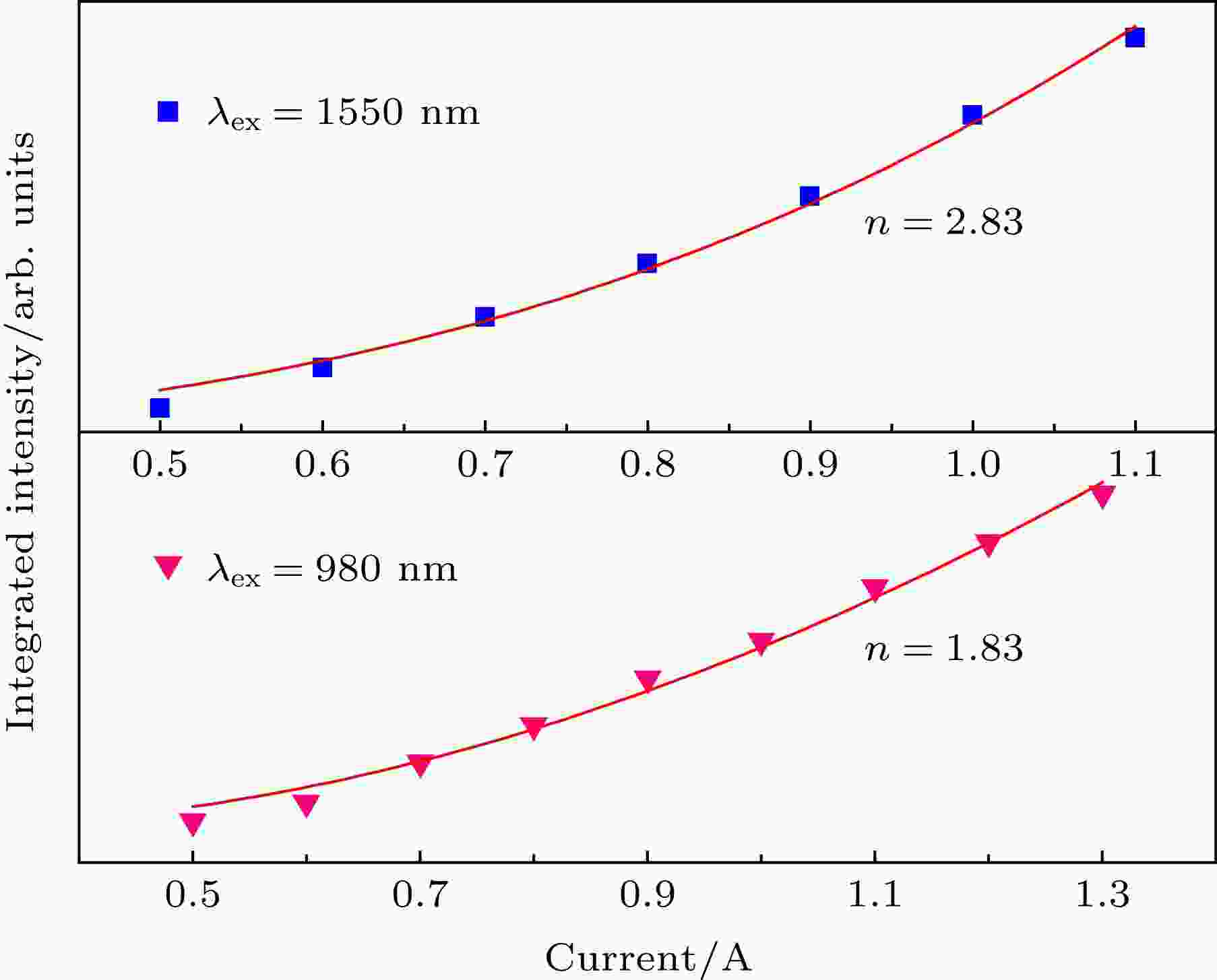 图 4 上转换发光强度积分与激光器工作电流的依赖关系
图 4 上转换发光强度积分与激光器工作电流的依赖关系Figure4. Dependence of the integrated intensity of up-conversion luminescence on laser working current.
2
3.4.温度对最优样品红光上转换发光的影响
为了研究温度对Ba8Gd5Zn4O21∶Er3+/Yb3+粉末上转换发光的影响, 改变温度, 对最优样品进行上转换发射光谱的测量, 并求出红光发光部分的积分面积. 图5(a)和图5(b)分别是980 nm和1550 nm激光激发下最优样品的红光上转换发光强度随温度的变化, 图中红光的上转换发光强度随着温度的升高而呈现下降的趋势.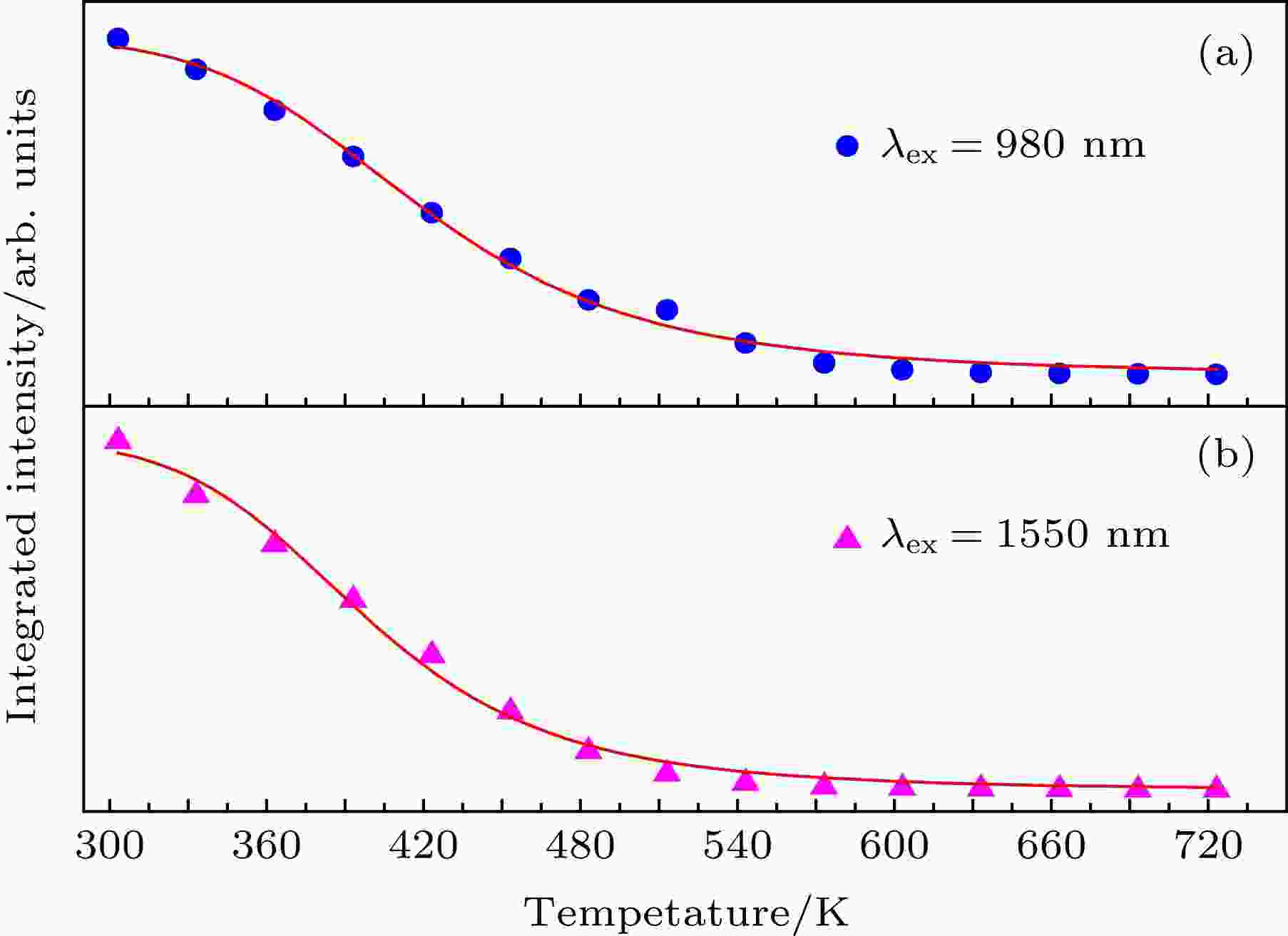 图 5 最优样品在(a) 980 nm与(b) 1550 nm激光激发下的红色上转换发光强度随温度的变化
图 5 最优样品在(a) 980 nm与(b) 1550 nm激光激发下的红色上转换发光强度随温度的变化Figure5. Dependence of red up-conversion luminescence intensity on temperature under (a) 980 nm and (b) 1550 nm excitation for optimal samples.
2
3.5.最优样品与NaYF4∶Er3+/Yb3+红光商品粉的发光强度比较
在980 nm和1550 nm激光激发下, 通过改变抽运工作电流分别测得NaYF4∶Er3+/Yb3+红光商品粉与最优样品的红光上转换光谱, 积分后进行比较, 如图6所示. 图6(a)和图6(c)为最优样品红光上转换发光强度积分; 图6(b)和图6(d)为NaYF4∶Er3+/Yb3+商品粉末的红光上转换发光强度积分. 通过对比可以看出, 此次制备的最优样品荧光粉红光上转换发光强度远强于NaYF4商品粉, 并且随着抽运电流的增强, 两者发光强度差呈增大趋势.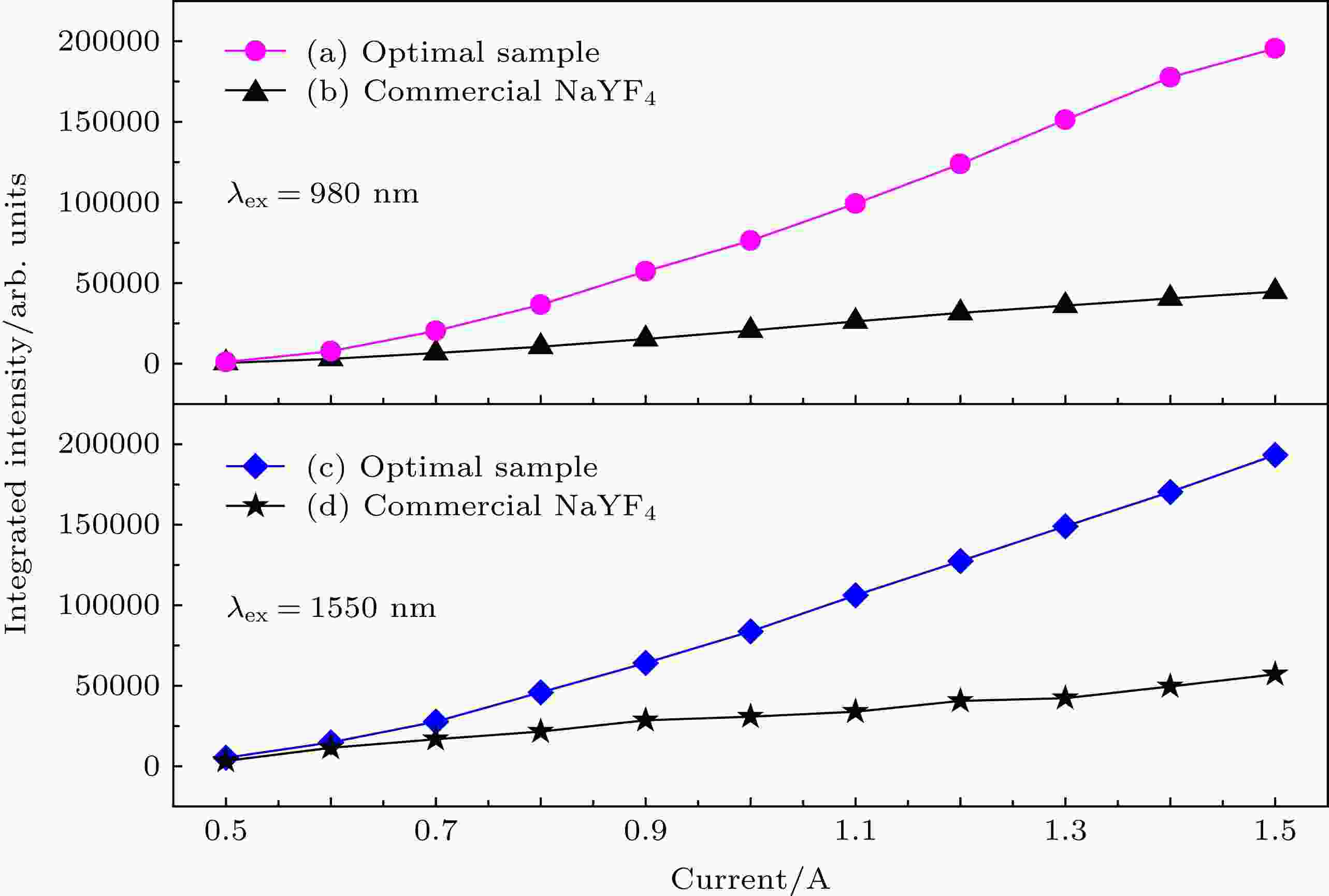 图 6 在(a), (b) 980 nm和(c), (d) 1550 nm激光激发下最优样品与NaYF4商品粉末发光强度的比较
图 6 在(a), (b) 980 nm和(c), (d) 1550 nm激光激发下最优样品与NaYF4商品粉末发光强度的比较Figure6. Dependence of red up-conversion luminescence intensity compared with commercial phosphor of NaYF4 under (a), (b) 980 nm and (c), (d) 1550 nm excitation for optimal samples.
图7为980 nm和1550 nm激光激发下最优样品与NaYF4商品粉末的红光发光强度的倍数比.
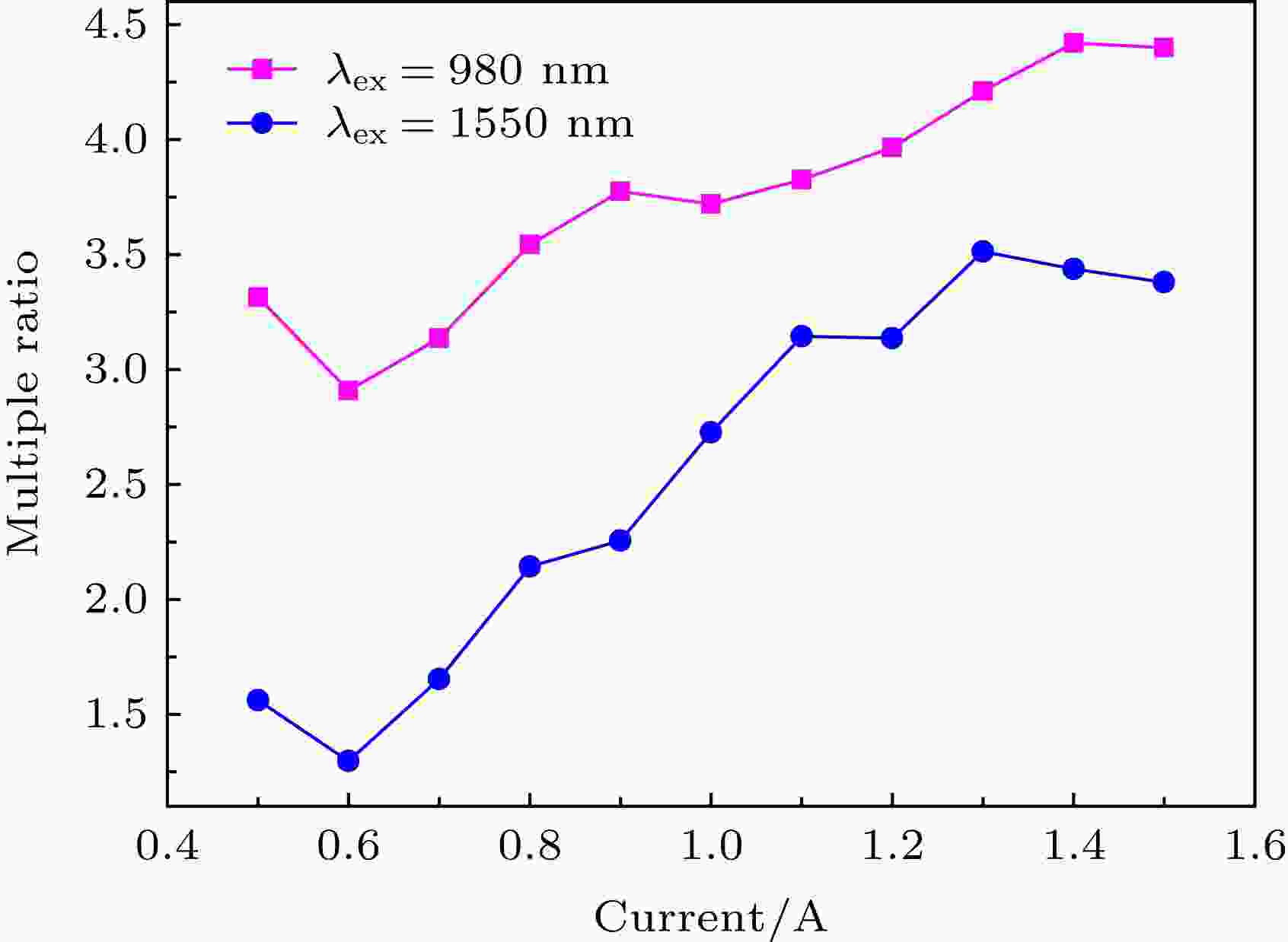 图 7 在980 nm和1550 nm激光激发下最优样品与NaYF4商品粉末发光强度的倍数比
图 7 在980 nm和1550 nm激光激发下最优样品与NaYF4商品粉末发光强度的倍数比Figure7. The Multiple ratio of red up-conversion luminescence intensity compared with commercial phosphor of NaYF4 under 980 nm and 1550 nm excitation for optimal samples.
将最优样品在相同激发功率密度下进行红光上转换发光强度的比较, 如图8所示, 图8(a)是1550 nm激光激发下的最优样品的红光上转换发光强度积分, 图8(b)是980 nm激光激发下的最优样品的红光上转换发光强度积分. 可以看出, 在相同激发功率密度的情况下, 980 nm激光激发下的最优样品比1550 nm激光激发下的最优样品红光上转换发光强度更强.
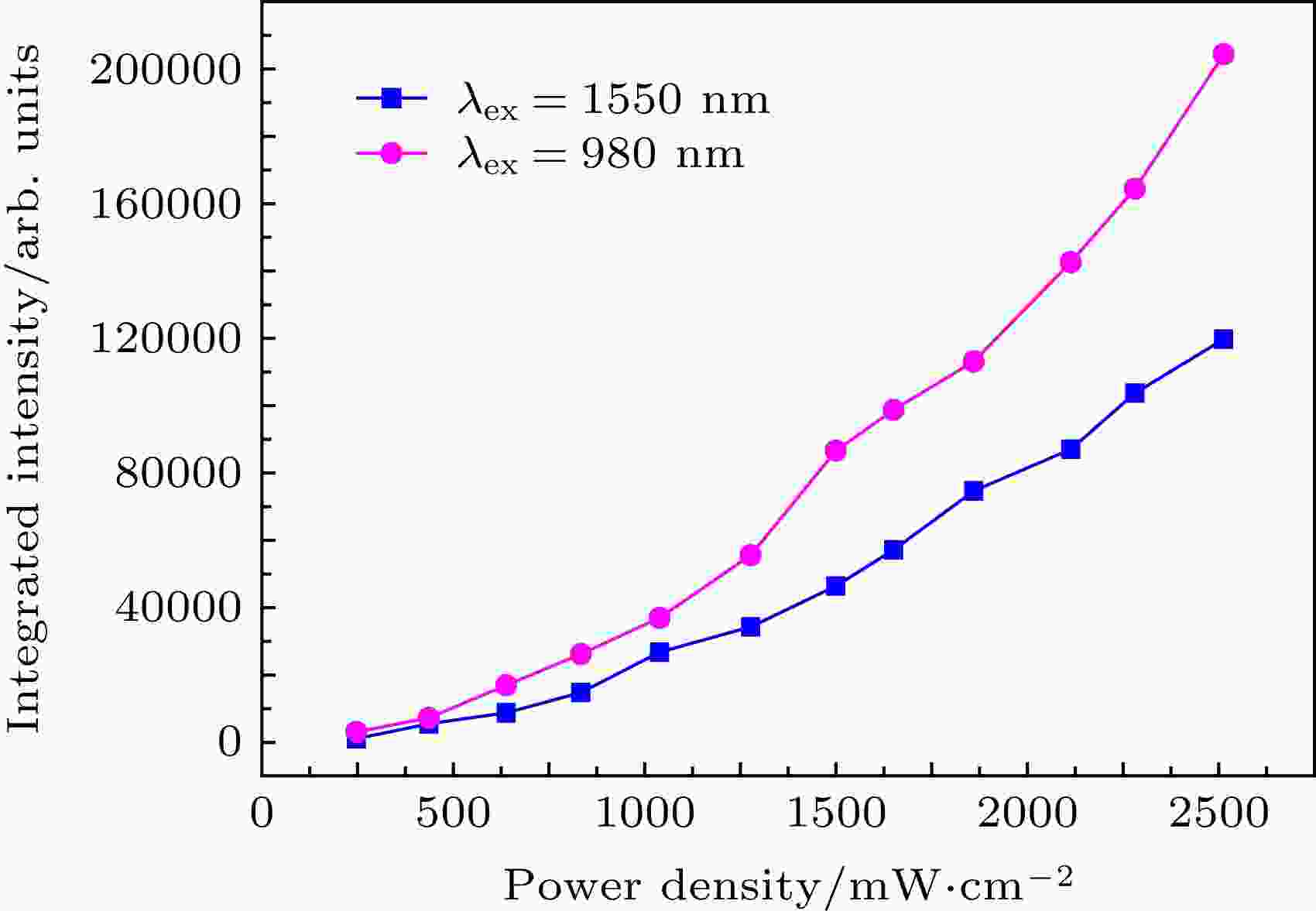 图 8 相同功率密度下最优样品的红光上转换发光强度比较
图 8 相同功率密度下最优样品的红光上转换发光强度比较Figure8. Comparison of red up-conversion luminescence intensity of optimal samples at the same power density.
